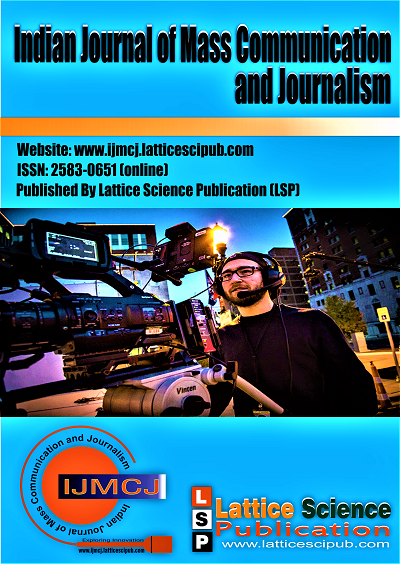Media Framing of COVID-19 Crisis in Print Media
Main Article Content
Abstract
Since the coronavirus outbreak, the Media houses have focused on the health crisis fittingly. The news of the pandemic spread faster than the virus itself. The impact of media does not only originate with what information is being disseminated but also how it is framed. It gives Mass Media the credit for forming Public Opinion. This study aims to determine and compare the dominant frames in coverage of COVID-19 news. Based on readership and popularity, two English and two Hindi newspapers are selected. The study, descriptive in nature, uses Content Analysis as a tool of analysis. With the deductive approach, the researcher considered pre-determined frames (extracted from the previous literature) analyzed and compared the stories according to them. The time frame of this study was two months, starting from April 1, when the second wave in India intensified, to May 31, 2021. The unit of analysis included all articles, features, and columns published within the time frame. It was discovered that the Hope frame (18.4%) and Fear frame (16.8%) dominated the overall study. It was also found that there were similarities and differences in framing used by both English and Hindi newspapers.
Downloads
Article Details

This work is licensed under a Creative Commons Attribution-NonCommercial-NoDerivatives 4.0 International License.
How to Cite
References
Johns Hopkins Coronavirus Resource Center. (2021). COVID-19 Map.
Gerlach, N. (2016). From outbreak to pandemic narrative: Reading newspaper coverage of the 2014 Ebola epidemic. Canadian Journal of Communication, 41(4). https://doi.org/10.22230/cjc.2016v41n4a3098
Mutua, S. N., & Ong'ong'a, D. O. (2020). Online News Media Framing of COVID-19 Pandemic: Probing the Initial Phases of the Disease Outbreak in International Media. European Journal of Interactive Multimedia and Education, 1(2), e02006. https://doi.org/10.30935/ejimed/8402
Jacob, R. (2020). Journal of Content, Community & Communication. 11(6)
McQuail, D. (2005). McQuail's mass communication theory (5th ed.). New Delhi, India: Vistaar Publications.
Semetko H, Valkenburg P. Framing European politics: a content analysis of press and television news. J Commun. 2000; 50 (2):93–109. https://doi.org/10.1111/j.1460-2466.2000.tb02843.x
Ogbodo, J. N., Onwe, E. C., Chukwu, J., Nwasum, C. J., Nwakpu, E. S., Nwankwo, S. U., Nwamini, S., Elem, S., & Iroabuchi Ogbaeja, N. (2020). Communicating health crisis: a content analysis of global media framing of COVID-19. Health promotion perspectives, 10(3). https://doi.org/10.34172/hpp.2020.40
Ruigrok, N., de Ridder, J. A., & Scholten, O. (2005). News coverage of the Bosnian war in Dutch newspapers: Impact and implications. In: P. Seib (Ed.), Media and Conflict in the twenty-first century. New York, NY: Palgrave Macmillan. https://doi.org/10.1057/9781403980335_8
Carpenter, S. (2007). U.S. elite and non-elite newspapers' portrayal of the Iraq war: A comparison of frames and source use. Journalism and Mass Communication Quarterly, 84(4), 761—776. https://doi.org/10.1177/107769900708400407
Bennett, W. L. (1990). Toward a theory of press-state relations in the United States. Journal of Communication, 40(2), 103--127. https://doi.org/10.1111/j.1460-2466.1990.tb02265.x
Neuman, W. R., Just, M. R., and Crigler, A. N. (1992). Common Knowledge. Chicago: University of Chicago Press. https://doi.org/10.7208/chicago/9780226161174.001.0001
Jo, W., & Chang, D. (2020). Political Consequences of COVID-19 and Media Framing in South Korea. Frontiers in public health, 8, 425. https://doi.org/10.3389/fpubh.2020.00425
Morissan, Abdul Wahab, J., Siang, T. G., & Cahyowati, T. D. (2020). Media Framing on Covid-19 Pandemic in Malaysian and Indonesian Newspapers. International Journal of Academic Research in Business and Social Sciences. 10(10), 800-812. https://doi.org/10.6007/IJARBSS/v10-i10/8016
Nwakpu, ES., Ezemma, VC., Ogbodo, JN. (2020). Nigeria media framing of coronavirus pandemic and audience response. Health Promotion Perspectives. 10(3) https://doi.org/10.34172/hpp.2020.32
Witte, K., & Allen, M. (2000). A Meta-Analysis of Fear Appeals: Implications for Effective Public Health Campaigns. Health Education & Behavior, 27(5), 591–615. https://doi.org/10.1177/109019810002700506
Boukes, M., Jones, N. P., & Vliegenthart, R. (2020). Newsworthiness and story prominence: How the presence of news factors relates to the upfront position and length of news stories. Journalism. https://doi.org/10.1177/1464884919899313
Joshi, D. A. (2021). COVID 19 Infodemic: Analysis of the Spread and Reach of Misinformation. In International Journal of Recent Technology and Engineering (IJRTE) (Vol. 9, Issue 5, pp. 195–201). https://doi.org/10.35940/ijrte.e5260.019521
Singh, D. (2020). COVID-19: Its Implications with a Focus on the Aviation Industry and How CRM and BI Can Play A Role. In International Journal of Management and Humanities (Vol. 5, Issue 2, pp. 52–56). https://doi.org/10.35940/ijmh.b1155.105220
Ibrahim, & Nasser. (2021). Post COVID-19 Impacts on Technology Adoption. In International Journal of Innovative Technology and Exploring Engineering (Vol. 10, Issue 11, pp. 47–50). https://doi.org/10.35940/ijitee.k9479.09101121
S, Dr. V., & S N, Dr. T. (2021). Machine Learning Approach using CNN for COVID-19 Pandemic Detection. In International Journal of Engineering and Advanced Technology (Vol. 11, Issue 2, pp. 63–67). https://doi.org/10.35940/ijeat.b3302.1211221
H. Almaliki, A. (2024). Water and COVID-19 Pandemic: A Literature Review. In International Journal of Emerging Science and Engineering (Vol. 12, Issue 7, pp. 1–6). https://doi.org/10.35940/ijese.g2570.12070624





